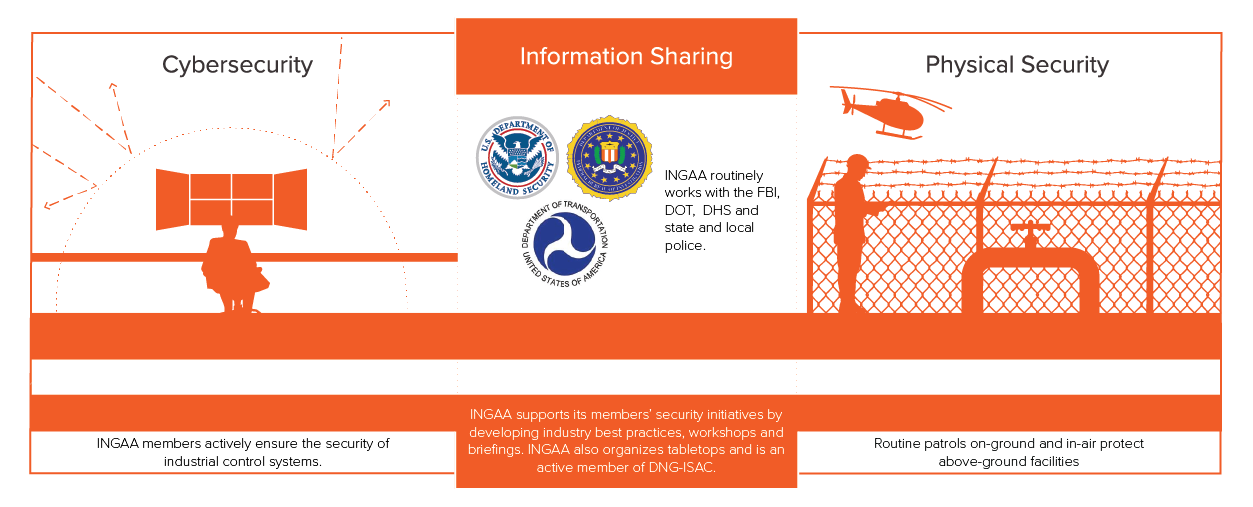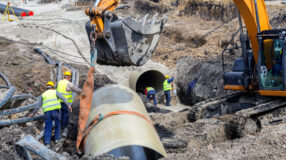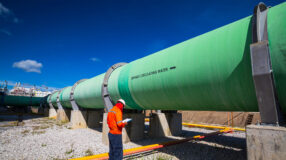Security
Natural gas pipelines are the critical infrastructure that moves one-third of the energy consumed daily in the United States. INGAA member companies understand how vital it is for this transportation network and the computer systems that operate it to be secure, reliable, and resilient.

Whether the threat is a natural cause, a terrorist activity, or a cyber incident, the design and operational practices of the natural gas pipeline system reduce the probability that an incident could have an adverse impact on a locality or the nation.
As part of its efforts to ensure reliability and safety, the natural gas pipeline industry works diligently to secure and protect its cyber and physical assets. Our first goal with these efforts is to safeguard the well-being of every citizen living and working near our assets. The second, broader goal is avoiding or mitigating the consequences that a loss of natural gas service could have on the thousands of individuals, businesses, industries, and electric generators that rely directly or indirectly on the natural gas provided by these pipelines.
Our efforts are extensive and varied. On the cybersecurity side, the computer systems that operate pipelines – the Supervisory Control and Data Acquisition (SCADA) system – are intentionally separated from other corporate computer systems to protect them from computer viruses or cyberthreats. On the physical security front, INGAA member companies use fences, routine patrols and continuous monitoring to protect above-ground facilities like compressor and meter stations. Concurrently, both cyber and physical security teams work together to understand the nuances of both threats and the convergence of cyber and physical security within the threat landscape for critical infrastructure.
INGAA members routinely hold briefings and workshops to discuss security concerns and continue to develop best practices to protect facilities and data. INGAA was instrumental in developing the US Transportation and Security Administration’s (TSA) physical and cybersecurity guidelines for the natural gas pipeline industry, and provided extensive input into the refinement of the TSA Security Directives for Pipeline Cybersecurity. INGAA organizes and participates in incident simulations – training exercises that present real-world challenges – to help the industry and government officials prepare and practice for a physical or cyber emergency.
INGAA has participated in several programs with the US Department of Homeland Security (DHS) and the US Department of Energy (DOE) to improve and streamline threat-information sharing throughout the industry and to facilitate two-way communications with the government. INGAA members also collaborate on initiatives within the Cybersecurity and Infrastructure Security Agency (CISA) designed to enhance communications between operators and the security technology community and engage in voluntary efforts to assess the cybersecurity posture of their networks.
As part of a continuing effort to enhance the security of its members’ physical assets and cyber networks, INGAA participates in the Downstream Natural Gas Information Sharing and Analysis Center (DNG-ISAC), the Oil and Natural Gas Information Sharing and Analysis Center (ONG-ISAC), and the Electricity Information Sharing and Analysis Center (E-ISAC).
ISACs are promoted by our federal government as a best practice for sharing threat information related to any critical infrastructure sector, and serve as a platform for sharing and accessing cyber and physical threat intelligence, incident information and analytics among local natural gas utilities and natural gas pipeline operators. This information, collected by participating members, is analyzed and shared among the natural gas sector, federal agencies, and state governments. The ISACs shares relevant information with other sectors’ ISACs that may be affected by security threats.
The natural gas pipeline industry has taken concrete steps to ensure the ability to recover from any incident — physical or cyber — quickly and effectively.
The physical operations of natural gas production, transmission and distribution make the system inherently reliable and resilient. Disruptions to natural gas infrastructure are rare. When they do happen, a disruption of the system does not necessarily result in an interruption of scheduled deliveries of natural gas supply because the natural gas system has many ways of offsetting the impact of disruptions.
Unlike electricity that travels at the speed of light, natural gas moves by pressure through pipelines at an average speed of 15-20 miles per hour. This allows time for pipeline operators to manage the flow of natural gas and to adjust their operations in the unlikely event of a disruption. Because of the pipeline operators’ ability to manage natural gas on their transportation systems, a failure at a single point on the system typically has only a localized effect, if any.
Moreover, most natural gas facilities include both manual shut-off and automated shut-off controls, which would prevent the entire system from suffering a large-scale failure if a “bad actor” sought to damage a facility or meddle with a section of the pipeline.
The actions taken by each INGAA member show commitment to the safety and trust of those they serve. The voluntary choice of its members to participate in information-sharing takes this commitment one step further, ensuring the safe and reliable delivery of natural gas to more than 177 million Americans homes and businesses.
Supervisory Control and Data Acquisition (SCADA) Systems
The following are a few of the agencies that regulate natural gas pipelines:
The Federal Energy Regulatory Commission (FERC) regulates such things as natural gas transportation rates, pipeline capacity, pipeline siting and natural gas quality requirements.
The U.S. Department of Transportation (DOT) Pipeline and Hazardous Materials Safety Administration (PHMSA) and their state and local agents provide regulation for the safe transportation of natural gas through pipelines.
The U.S. Environmental Protection Agency (EPA), the Fish and Wildlife Service and state environmental protection agencies provide regulations for protection of the environment and cultural resources during the construction and operation of pipeline facilities.
The U.S. Occupational Safety and Health Administration (OSHA) provides regulation for the safe working place for personnel.
You can find out if there is a pipeline near you by checking the National Pipeline Mapping System Public Map Viewer at www.npms.phmsa.dot.gov
Also, look for pipeline markers. These are signs, located at regular intervals, that include information about the product transported and the transmission pipeline operator.
If you have a pipeline on your property, you will get regular mailings from the pipeline owner. Be sure to read any mailings you receive from pipeline companies!
Think of a natural gas pipeline as an energy highway. American pipelines transport natural gas from nearly 275,000 gas wells in various production areas of the country over hundreds or thousands of miles to customers in cities, towns and industrial facilities.
The gas is compressed when it comes out of the wells, and this compression helps it move at about 15 miles per hour through the pipes. Though the friction of the gas against the pipes slows it down at some points along the way, the pipelines operate compressor stations at points about 75 miles apart along the route to compress the natural gas and then push it along. The natural gas in a pipeline is roughly the same temperature as the earth around the pipeline, though the periodic compression can increase the temperature for a short distance.
The gas moves relatively quietly on its journey through the pipeline system. The only noise comes at the compressor stations, whose motors generate the equivalent noise of a plane engine. To minimize noise, compressor stations, which are about the size of a barn, are insulated and operate under federal regulations and specifications. Natural gas is delivered to local gas distribution companies (LDCs), which in turn distribute the gas to homes, businesses and factories. Pipelines also deliver gas to end-users, such as electric generators.







